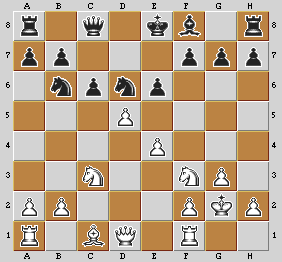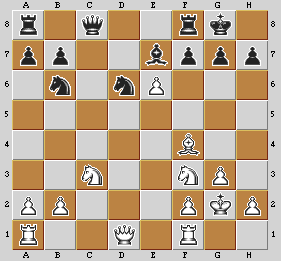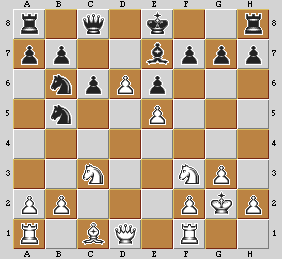
Sample Chess Lesson II

White to move
So, let's get to work: how are you supposed to find the "best" move in the position above? It is obviously not a combination, so it is so hard to be certain of which way to go - we can not just calculate that we are winning a queen or checkmating. It is a little like the difference between essay and multiple choice tests.
My intention is to prove that with a careful analysis of the position, which in such cases becomes extremely important, and knowing some of the basic chess principles, you too can find the right move!
Alright, let's begin our position scan. It is clear that we have the same number of pieces, but how about the positional equilibrium - is anyone better? I think we can find an answer to this question using two familiar concepts: development of pieces, and space & center. You have to agree with me that white is better developed. He has already castled, so is a couple of tempos ahead of his opponent. But as we know, level of development is not a sufficient measure, we also have to look at where the pieces are developed. Well, fortunately, our two knights have very good squares (as opposed to their black counterparts) and our bishop can choose from several good looking squares (once again, as opposed to its black counterpart).
If we move on to the next item, things look even better: we control the center, and we definitely have more space (you don't have to be a GM to see that - even someone who doesn't play chess can notice it!) So, you must agree that white's position is better, and I am sure that if this was my only question you all would have guessed it right.
Having finished the position analysis, let's try to find our good move. The first extremely important thing I have to remark, is that in such positions we are very often tempted by mechanical moves (they are sometimes called 'hand moves' because our hand makes them instead of the brain!). Have you ever asked yourself why so many people fall into traps in the opening? The answer is simple: in the opening we tend to develop our pieces and not look very carefully at what's happening. I would argue that in the position above, if you were to think only for 30 seconds, you would definitely play Bf4 - it is the typical move that we would play mechanically, without giving much thought!
Let me make this point very clear: unless we are in big time trouble, or we know the variation by heart, or we have an only move (such as taking back in a trade, or moving out of check) we should never make mechanical moves! We have to try spending a little time at each move, and even if we make the same move, it shouldn't be an automatic, mechanical process, but a cognitive one!
Getting back to our particular position, Bf4 is clearly not a bad move, but as you will see shortly it is not the best move either. I will use one of the future lectures to illustrate the disasters to which mechanical or 'hand' moves can lead.
So, what is the good move? Well, in order to find that we have to know and remember a very important principle: "the better developed side should try to open up the game" Actually, it is a fairly logical idea: if you're better developed but the game is closed, you can't use your pieces for too much... On the other hand, in an open game, your advantage in development can prove overwhelming. In our particular position, there is one more principle that can help us: "if your opponent's king is in the center, you should open the center" Another very logical idea: let's take the pawns that defend the king in the center, and he will be at our mercy.
I am sure that if you know these principles and remember them at the board, you would easily find white's best move: 1.d5

Black finds himself in a very difficult position: if he trades the pawns, he ignores one of the main principles "don't let the game open up if you are poorly developed or your king is in the center", on the other hand if he tries to ignore it, white will gain so much space, it won't be easy to survive.
I will leave you the pleasure of calculating what happens if black takes the pawn on d5, but believe me, it is nothing pleasant. For instance if 1...cd5 2.ed5 Be7, now white can play 3.Bf4 because black's attempt to castle with 3...0-0 ends in trouble after 4.de6:

If black plays the natural 4...Qe6, white has a nice little combination: 5.Re1 Qf6 6.Re7 Qe7 7.Bd6 and white remains a knight up. Now, please understand that calculating this variation is nice, but not absolutely necessary in order to choose 1.d5. Just following the principles and calculating only a little bit would do it just as nicely in that position.
The game itself continued with 1... Be7, which allowed white to obtain incredible space after 2.e5 Nb5 3.d6:

The game, of course, continued for a number of moves, but you have to admit that white's position has improved considerably. Not surprisingly, white eventually won...
TotalChess.com™ and Internet Chess Academy™ are trademarks of Caissa International Corporation. Copyright © 1996-2005 Gabriel Schwartzman. All rights reserved.